Economic Principles & Decision Making: Module 1 Assignment ECON6000
VerifiedAdded on 2023/04/10
|5
|887
|262
Homework Assignment
AI Summary
This economics assignment analyzes two key problems related to economic principles and decision-making. Problem A examines production possibilities using a Production Possibilities Frontier (PPF) for two goods, Scmeckt Gut 2.0 and Scmeckt Gut Energy Bar, addressing a demand-supply mismatch in District D and suggesting solutions such as increased resource allocation, imports, and technological advancements, considering their sustainability. Problem B focuses on determining the equilibrium price and quantity using supply and demand functions, analyzing the inverse and direct relationships between price and quantity in demand and supply equations, respectively. The assignment applies economic concepts to real-world scenarios, demonstrating how to solve problems related to production, demand, and supply.
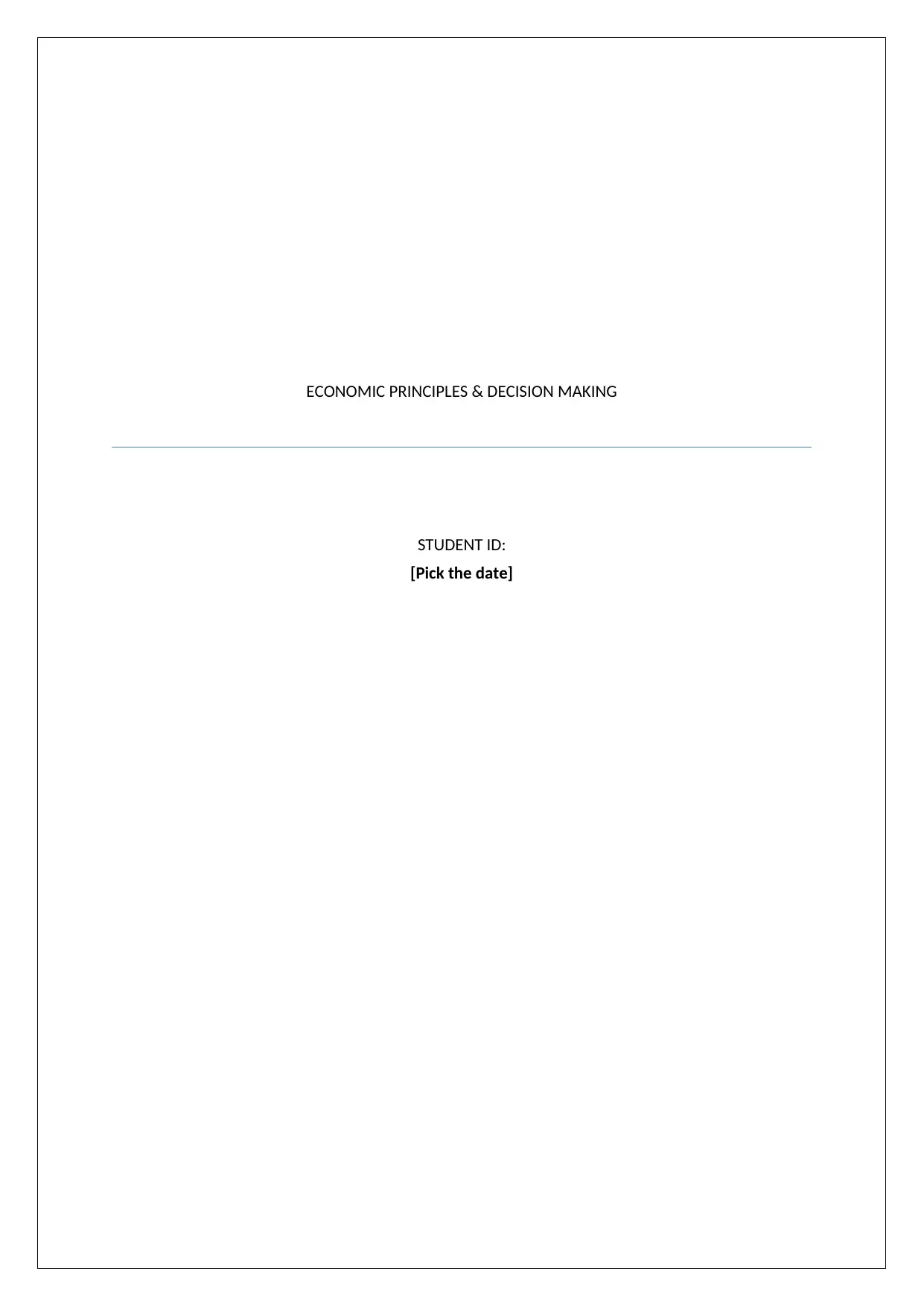
ECONOMIC PRINCIPLES & DECISION MAKING
STUDENT ID:
[Pick the date]
STUDENT ID:
[Pick the date]
Paraphrase This Document
Need a fresh take? Get an instant paraphrase of this document with our AI Paraphraser
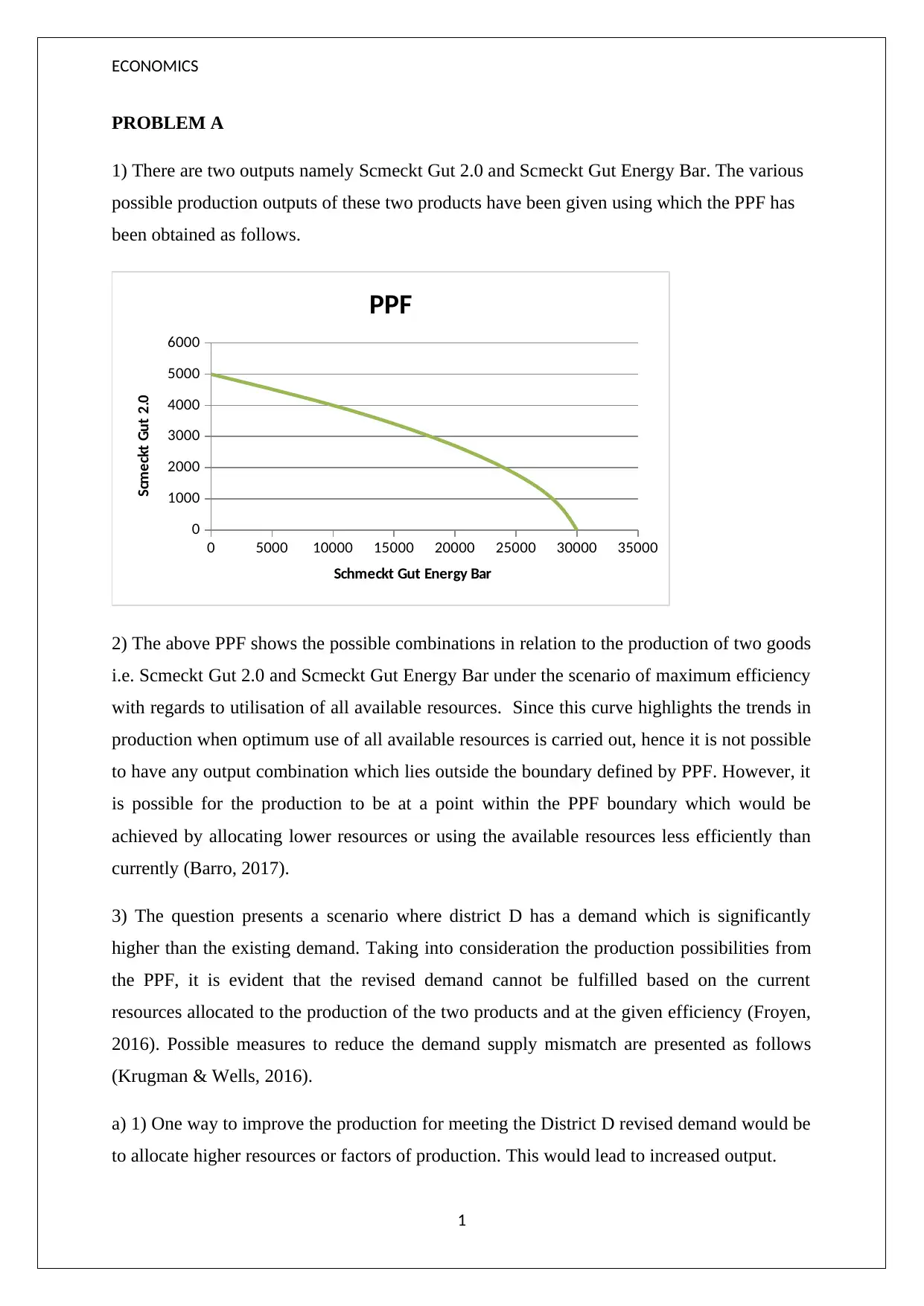
ECONOMICS
PROBLEM A
1) There are two outputs namely Scmeckt Gut 2.0 and Scmeckt Gut Energy Bar. The various
possible production outputs of these two products have been given using which the PPF has
been obtained as follows.
0 5000 10000 15000 20000 25000 30000 35000
0
1000
2000
3000
4000
5000
6000
PPF
Schmeckt Gut Energy Bar
Scmeckt Gut 2.0
2) The above PPF shows the possible combinations in relation to the production of two goods
i.e. Scmeckt Gut 2.0 and Scmeckt Gut Energy Bar under the scenario of maximum efficiency
with regards to utilisation of all available resources. Since this curve highlights the trends in
production when optimum use of all available resources is carried out, hence it is not possible
to have any output combination which lies outside the boundary defined by PPF. However, it
is possible for the production to be at a point within the PPF boundary which would be
achieved by allocating lower resources or using the available resources less efficiently than
currently (Barro, 2017).
3) The question presents a scenario where district D has a demand which is significantly
higher than the existing demand. Taking into consideration the production possibilities from
the PPF, it is evident that the revised demand cannot be fulfilled based on the current
resources allocated to the production of the two products and at the given efficiency (Froyen,
2016). Possible measures to reduce the demand supply mismatch are presented as follows
(Krugman & Wells, 2016).
a) 1) One way to improve the production for meeting the District D revised demand would be
to allocate higher resources or factors of production. This would lead to increased output.
1
PROBLEM A
1) There are two outputs namely Scmeckt Gut 2.0 and Scmeckt Gut Energy Bar. The various
possible production outputs of these two products have been given using which the PPF has
been obtained as follows.
0 5000 10000 15000 20000 25000 30000 35000
0
1000
2000
3000
4000
5000
6000
PPF
Schmeckt Gut Energy Bar
Scmeckt Gut 2.0
2) The above PPF shows the possible combinations in relation to the production of two goods
i.e. Scmeckt Gut 2.0 and Scmeckt Gut Energy Bar under the scenario of maximum efficiency
with regards to utilisation of all available resources. Since this curve highlights the trends in
production when optimum use of all available resources is carried out, hence it is not possible
to have any output combination which lies outside the boundary defined by PPF. However, it
is possible for the production to be at a point within the PPF boundary which would be
achieved by allocating lower resources or using the available resources less efficiently than
currently (Barro, 2017).
3) The question presents a scenario where district D has a demand which is significantly
higher than the existing demand. Taking into consideration the production possibilities from
the PPF, it is evident that the revised demand cannot be fulfilled based on the current
resources allocated to the production of the two products and at the given efficiency (Froyen,
2016). Possible measures to reduce the demand supply mismatch are presented as follows
(Krugman & Wells, 2016).
a) 1) One way to improve the production for meeting the District D revised demand would be
to allocate higher resources or factors of production. This would lead to increased output.
1
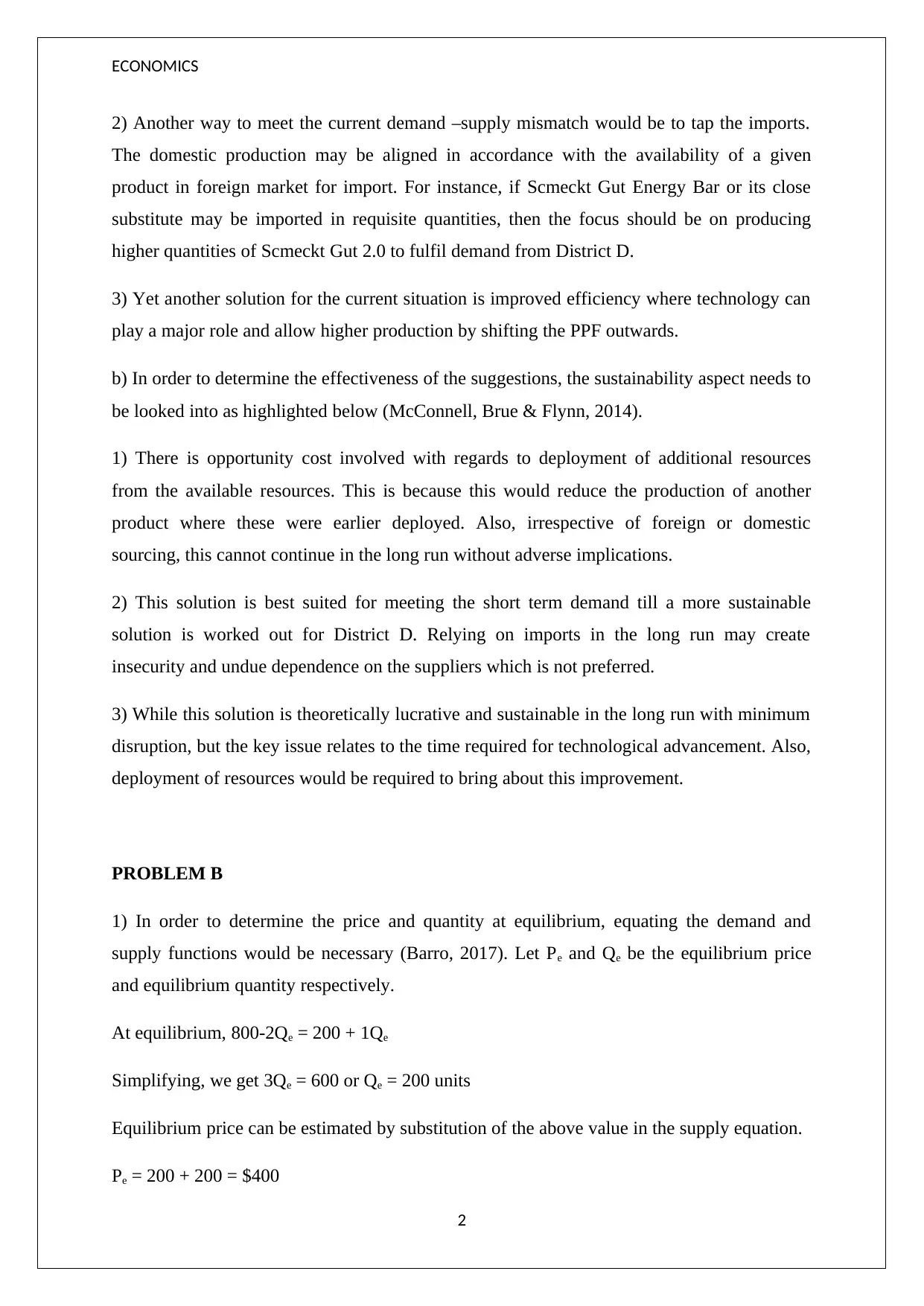
ECONOMICS
2) Another way to meet the current demand –supply mismatch would be to tap the imports.
The domestic production may be aligned in accordance with the availability of a given
product in foreign market for import. For instance, if Scmeckt Gut Energy Bar or its close
substitute may be imported in requisite quantities, then the focus should be on producing
higher quantities of Scmeckt Gut 2.0 to fulfil demand from District D.
3) Yet another solution for the current situation is improved efficiency where technology can
play a major role and allow higher production by shifting the PPF outwards.
b) In order to determine the effectiveness of the suggestions, the sustainability aspect needs to
be looked into as highlighted below (McConnell, Brue & Flynn, 2014).
1) There is opportunity cost involved with regards to deployment of additional resources
from the available resources. This is because this would reduce the production of another
product where these were earlier deployed. Also, irrespective of foreign or domestic
sourcing, this cannot continue in the long run without adverse implications.
2) This solution is best suited for meeting the short term demand till a more sustainable
solution is worked out for District D. Relying on imports in the long run may create
insecurity and undue dependence on the suppliers which is not preferred.
3) While this solution is theoretically lucrative and sustainable in the long run with minimum
disruption, but the key issue relates to the time required for technological advancement. Also,
deployment of resources would be required to bring about this improvement.
PROBLEM B
1) In order to determine the price and quantity at equilibrium, equating the demand and
supply functions would be necessary (Barro, 2017). Let Pe and Qe be the equilibrium price
and equilibrium quantity respectively.
At equilibrium, 800-2Qe = 200 + 1Qe
Simplifying, we get 3Qe = 600 or Qe = 200 units
Equilibrium price can be estimated by substitution of the above value in the supply equation.
Pe = 200 + 200 = $400
2
2) Another way to meet the current demand –supply mismatch would be to tap the imports.
The domestic production may be aligned in accordance with the availability of a given
product in foreign market for import. For instance, if Scmeckt Gut Energy Bar or its close
substitute may be imported in requisite quantities, then the focus should be on producing
higher quantities of Scmeckt Gut 2.0 to fulfil demand from District D.
3) Yet another solution for the current situation is improved efficiency where technology can
play a major role and allow higher production by shifting the PPF outwards.
b) In order to determine the effectiveness of the suggestions, the sustainability aspect needs to
be looked into as highlighted below (McConnell, Brue & Flynn, 2014).
1) There is opportunity cost involved with regards to deployment of additional resources
from the available resources. This is because this would reduce the production of another
product where these were earlier deployed. Also, irrespective of foreign or domestic
sourcing, this cannot continue in the long run without adverse implications.
2) This solution is best suited for meeting the short term demand till a more sustainable
solution is worked out for District D. Relying on imports in the long run may create
insecurity and undue dependence on the suppliers which is not preferred.
3) While this solution is theoretically lucrative and sustainable in the long run with minimum
disruption, but the key issue relates to the time required for technological advancement. Also,
deployment of resources would be required to bring about this improvement.
PROBLEM B
1) In order to determine the price and quantity at equilibrium, equating the demand and
supply functions would be necessary (Barro, 2017). Let Pe and Qe be the equilibrium price
and equilibrium quantity respectively.
At equilibrium, 800-2Qe = 200 + 1Qe
Simplifying, we get 3Qe = 600 or Qe = 200 units
Equilibrium price can be estimated by substitution of the above value in the supply equation.
Pe = 200 + 200 = $400
2
⊘ This is a preview!⊘
Do you want full access?
Subscribe today to unlock all pages.

Trusted by 1+ million students worldwide
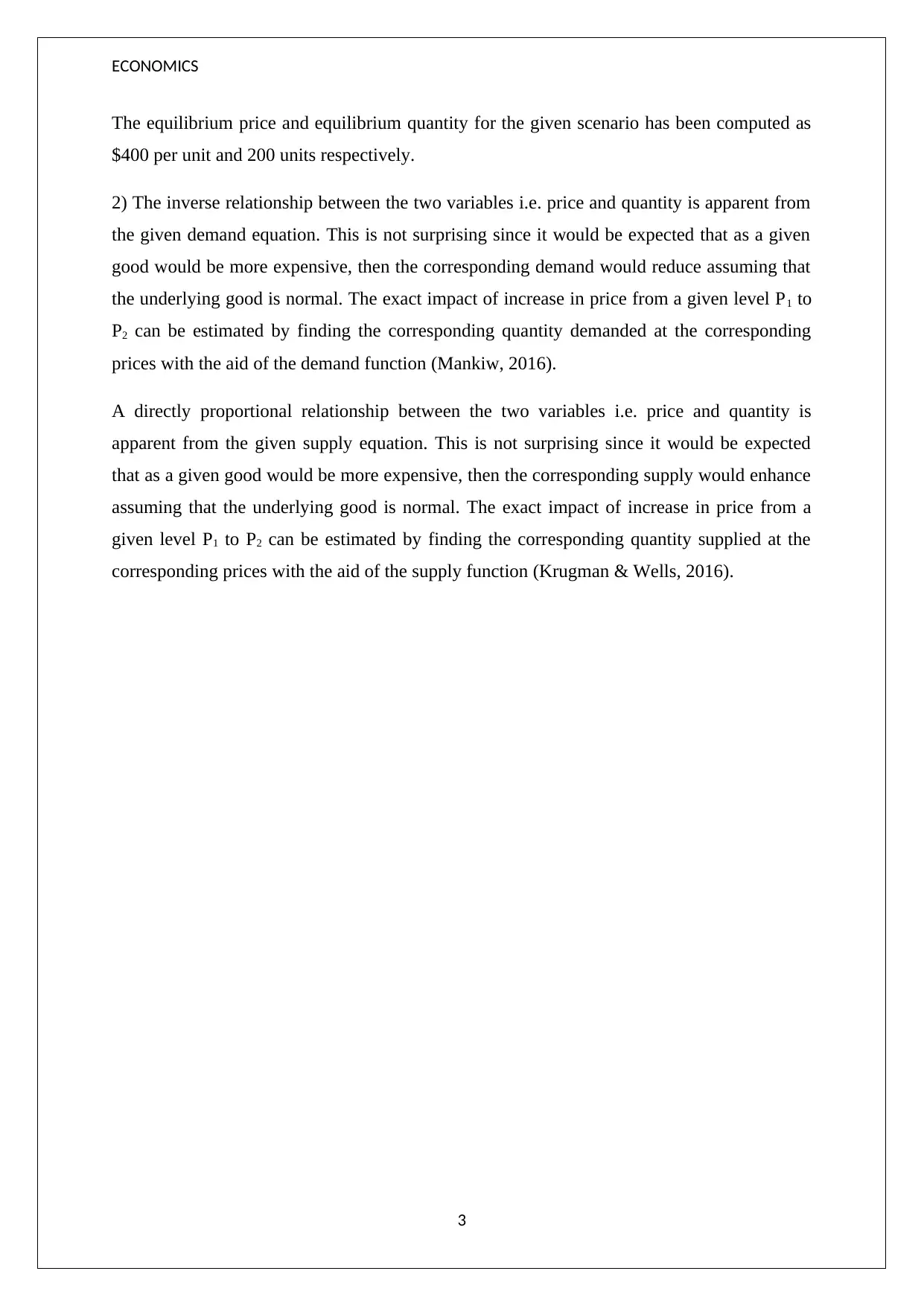
ECONOMICS
The equilibrium price and equilibrium quantity for the given scenario has been computed as
$400 per unit and 200 units respectively.
2) The inverse relationship between the two variables i.e. price and quantity is apparent from
the given demand equation. This is not surprising since it would be expected that as a given
good would be more expensive, then the corresponding demand would reduce assuming that
the underlying good is normal. The exact impact of increase in price from a given level P1 to
P2 can be estimated by finding the corresponding quantity demanded at the corresponding
prices with the aid of the demand function (Mankiw, 2016).
A directly proportional relationship between the two variables i.e. price and quantity is
apparent from the given supply equation. This is not surprising since it would be expected
that as a given good would be more expensive, then the corresponding supply would enhance
assuming that the underlying good is normal. The exact impact of increase in price from a
given level P1 to P2 can be estimated by finding the corresponding quantity supplied at the
corresponding prices with the aid of the supply function (Krugman & Wells, 2016).
3
The equilibrium price and equilibrium quantity for the given scenario has been computed as
$400 per unit and 200 units respectively.
2) The inverse relationship between the two variables i.e. price and quantity is apparent from
the given demand equation. This is not surprising since it would be expected that as a given
good would be more expensive, then the corresponding demand would reduce assuming that
the underlying good is normal. The exact impact of increase in price from a given level P1 to
P2 can be estimated by finding the corresponding quantity demanded at the corresponding
prices with the aid of the demand function (Mankiw, 2016).
A directly proportional relationship between the two variables i.e. price and quantity is
apparent from the given supply equation. This is not surprising since it would be expected
that as a given good would be more expensive, then the corresponding supply would enhance
assuming that the underlying good is normal. The exact impact of increase in price from a
given level P1 to P2 can be estimated by finding the corresponding quantity supplied at the
corresponding prices with the aid of the supply function (Krugman & Wells, 2016).
3
Paraphrase This Document
Need a fresh take? Get an instant paraphrase of this document with our AI Paraphraser
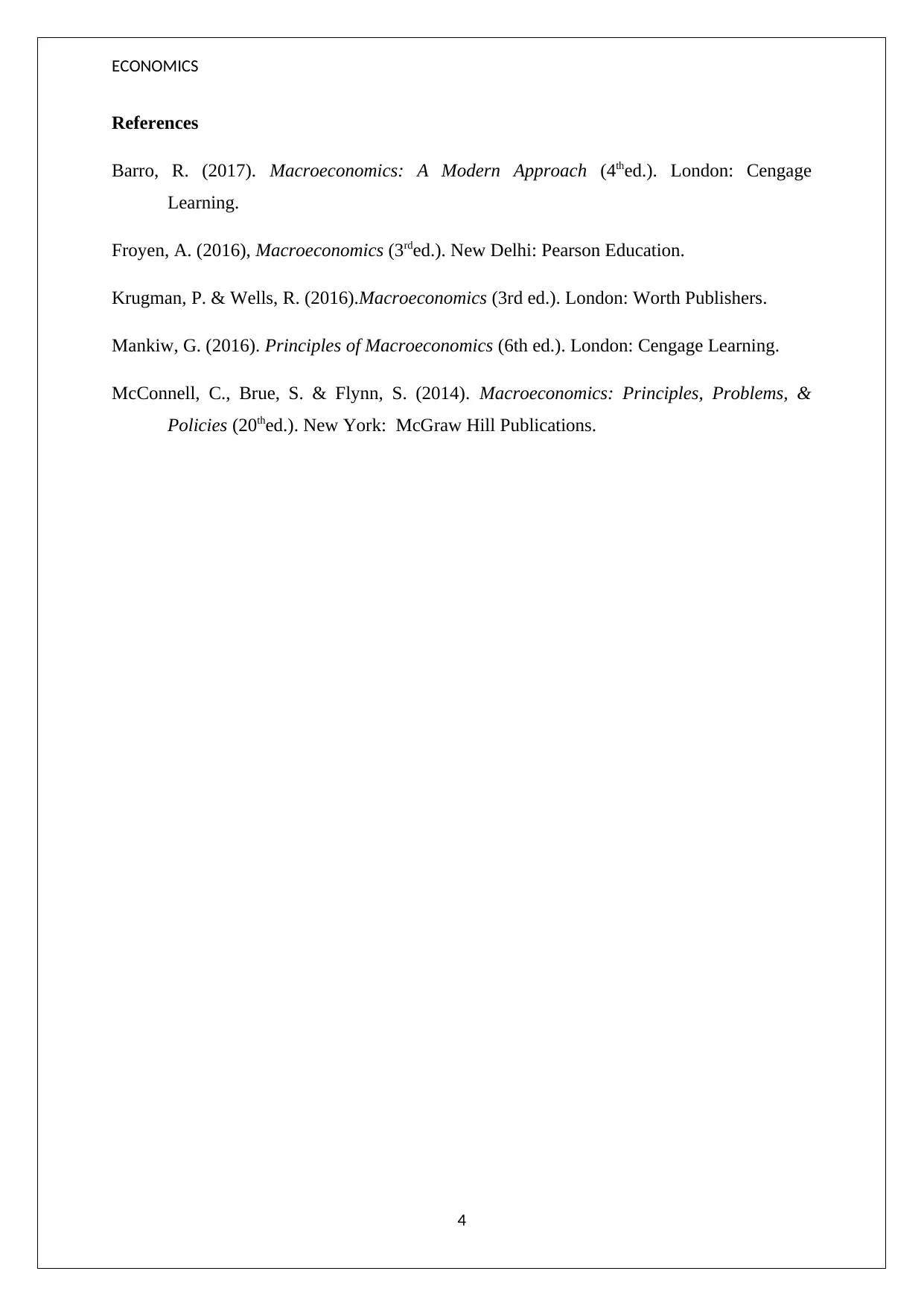
ECONOMICS
References
Barro, R. (2017). Macroeconomics: A Modern Approach (4thed.). London: Cengage
Learning.
Froyen, A. (2016), Macroeconomics (3rded.). New Delhi: Pearson Education.
Krugman, P. & Wells, R. (2016).Macroeconomics (3rd ed.). London: Worth Publishers.
Mankiw, G. (2016). Principles of Macroeconomics (6th ed.). London: Cengage Learning.
McConnell, C., Brue, S. & Flynn, S. (2014). Macroeconomics: Principles, Problems, &
Policies (20thed.). New York: McGraw Hill Publications.
4
References
Barro, R. (2017). Macroeconomics: A Modern Approach (4thed.). London: Cengage
Learning.
Froyen, A. (2016), Macroeconomics (3rded.). New Delhi: Pearson Education.
Krugman, P. & Wells, R. (2016).Macroeconomics (3rd ed.). London: Worth Publishers.
Mankiw, G. (2016). Principles of Macroeconomics (6th ed.). London: Cengage Learning.
McConnell, C., Brue, S. & Flynn, S. (2014). Macroeconomics: Principles, Problems, &
Policies (20thed.). New York: McGraw Hill Publications.
4
1 out of 5
Related Documents
Your All-in-One AI-Powered Toolkit for Academic Success.
+13062052269
info@desklib.com
Available 24*7 on WhatsApp / Email
![[object Object]](/_next/static/media/star-bottom.7253800d.svg)
Unlock your academic potential
Copyright © 2020–2025 A2Z Services. All Rights Reserved. Developed and managed by ZUCOL.




